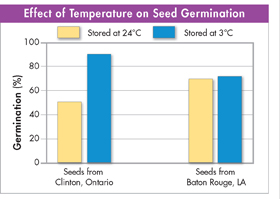Analyzing Data
Temperature and Seed Germination
Arisaema dracontium—“green dragon”—is a plant that grows from the southern United States to Canada. The graph shows germination rates of Arisaema seeds gathered from two locations and stored at two different temperatures.
Interpret Graphs What effect does chilling have on germination of seeds from Ontario? How does it affect the seeds from Louisiana?
Form a Hypothesis Describe how the different rates of seed germination might be explained in terms of adaptation to the local climate.
Seed Dormancy and Germination
 What factors influence the dormancy and germination of seeds?
What factors influence the dormancy and germination of seeds?
Some seeds sprout so rapidly that they are practically instant plants. Bean seeds are a good example. With proper amounts of water and warmth, a mature bean seed rapidly sprouts and develops into a green plant. But many seeds will not grow when they first mature. Instead, these seeds enter a period of dormancy, during which the embryo is alive but not growing. The length of dormancy varies in different species. Germination is the resumption of growth of the plant embryo.  Environmental factors such as temperature and moisture can cause a seed to end dormancy and germinate.
Environmental factors such as temperature and moisture can cause a seed to end dormancy and germinate.
BUILD Vocabulary
WORD ORIGINS The word dormancy comes from the Latin word dormire, meaning “to sleep.”
How Seeds Germinate Before germinating, seeds absorb water. The absorbed water causes food-storing tissues to swell, cracking open the seed coat. Through the cracked seed coat, the young root emerges and begins to grow. The shoot—the part of the plant that will grow above ground—emerges next.
The Role of Cotyledons Cotyledons are a flowering plant's first leaves. Their job is to store nutrients and then transfer them to the growing embryo as the seed germinates. Figure 24–11 compares germination in a monocot and a dicot. Monocots have a single cotyledon, which usually remains underground while it passes nutrients to the young plant. The growing monocot shoot emerges from the soil protected by a sheath. In dicots, which have two cotyledons, there is no sheath to protect the tip of the young plant. Instead, the upper end of the shoot bends to form a hook that forces its way through the soil. This protects the delicate tip of the plant, which straightens as it emerges into the sunlight. In some species, the cotyledons appear above ground as the plant emerges, while in others, such as the garden pea, the cotyledons remain underground.
MYSTERY CLUE

What variables in the lemons' environment could have changed with the switch to electric heating? Start a list of variables that affect seed development and fruit ripening. Add to your list as you continue reading the chapter.
Table of Contents
- Formulas and Equations
- Applying Formulas and Equations
- Mean, Median, and Mode
- Estimation
- Using Measurements in Calculations
- Effects of Measurement Errors
- Accuracy
- Precision
- Comparing Accuracy and Precision
- Significant Figures
- Calculating With Significant Figures
- Scientific Notation
- Calculating With Scientific Notation
- Dimensional Analysis
- Applying Dimensional Analysis





